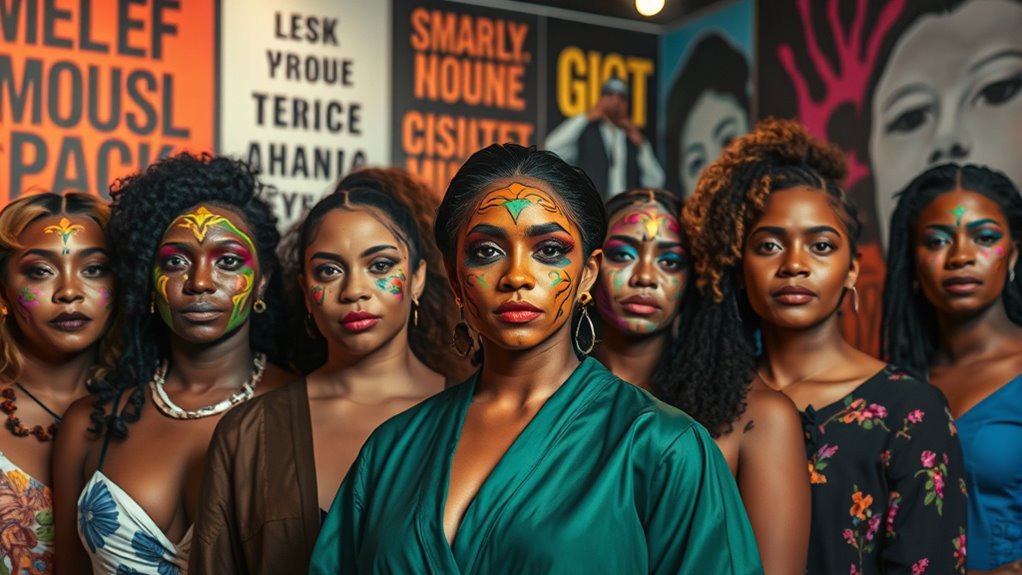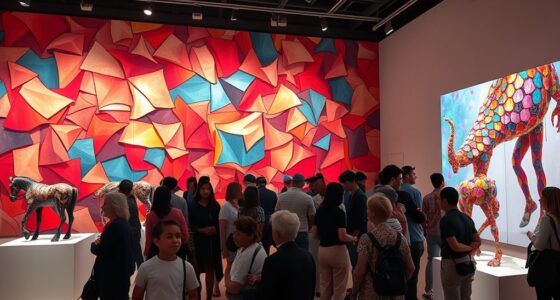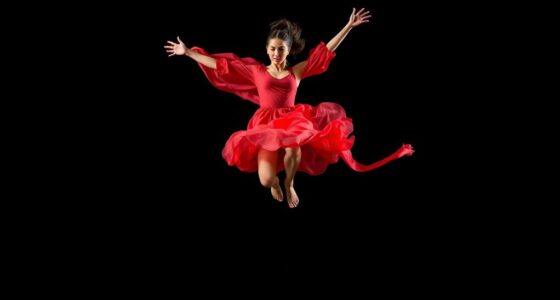Feminist and identity art challenge dominant narratives by confronting societal norms and amplifying marginalized voices through provocative and boundary-pushing creations. You’ll see artists question stereotypes, promote visibility, and foster inclusivity, all while disrupting conventional aesthetics. Their work pushes viewers to rethink stereotypes around gender, race, and identity. If you continue exploring, you’ll uncover how these bold artistic acts inspire dialogue and promote social change by breaking down barriers and encouraging empathy.
Key Takeaways
- Feminist and identity art challenge societal norms by highlighting marginalized voices and questioning traditional power structures.
- It employs activism and disruptive techniques to confront stereotypes and promote social justice within contemporary art.
- These artworks foster inclusivity by representing diverse identities, emphasizing authenticity, and encouraging empathy.
- Intersectional approaches reveal layered oppressions related to race, gender, sexuality, and class, urging nuanced understanding.
- Such art aims to inspire social change through responsible representation, dialogue, and collective action.

Have you ever wondered how art can challenge societal norms and amplify marginalized voices? Feminist and identity art serve as powerful tools to question established ideas, push boundaries, and foster dialogue around issues often left unspoken. When you explore these art forms, you see more than just visuals—you witness activism in action. They confront stereotypes, highlight injustices, and create spaces where marginalized communities can tell their stories authentically. At the core of this movement is intersectional activism, which recognizes how various identities—race, gender, sexuality, class—intersect to shape individual experiences. Artists who embrace intersectionality use their work to shed light on layered oppressions, emphasizing that one-size-fits-all solutions don’t work. This approach empowers viewers to understand the complexity of identity and challenges you to think beyond single-axis narratives. Queer representation is another essential aspect of feminist and identity art. It pushes for visibility and acceptance of LGBTQ+ communities, often in spaces where they’ve historically been erased or marginalized. When you encounter pieces that showcase queer experiences, you’re invited into worlds that defy societal expectations and challenge heteronormative standards. These artworks don’t just depict queer lives; they celebrate them, question societal prejudices, and foster empathy. Through vivid imagery, provocative symbolism, and bold storytelling, artists create a dialogue that questions traditional gender roles, heteronormativity, and cisnormativity. By centering queer narratives, they demand recognition and affirmation, urging you to reconsider preconceived notions about sexuality and gender identity. Feminist and identity art also serve as acts of resistance, confronting cultural stigmas and advocating for social change. They often disrupt conventional aesthetics, using unconventional materials or abstract forms to emphasize their messages. When you engage with these works, you become part of a broader conversation about equality and justice. They challenge you to reflect on your own biases and to recognize the power of representation in shaping societal attitudes. Incorporating diversity considerations in visual art enhances the authenticity and emotional impact of the work. Recognizing the importance of ethical hacking principles in art practices can also promote responsible and respectful representation of marginalized groups. Moreover, fostering an environment that values inclusive design can help ensure that art spaces are welcoming and accessible to diverse audiences. Ultimately, it’s about breaking down barriers, fostering empathy, and inspiring collective action toward a more inclusive future.
Frequently Asked Questions
How Has Feminist Art Evolved Over the Past Century?
You see that over the past century, feminist art has evolved from simply highlighting gender representation to becoming a powerful tool for political activism. You notice artists challenge traditional norms, question societal roles, and push for equality. This movement continuously adapts, using diverse media and perspectives, inspiring change and fostering dialogue around gender issues. Through this evolution, feminist art remains a crucial force in shaping contemporary conversations on identity and social justice.
What Are the Key Differences Between Feminist and Identity Art?
Did you know that 85% of viewers notice diverse representation in art first? When comparing feminist and identity art, you’ll see that feminist art often emphasizes broad gender equality, while identity art dives into intersectionality dynamics, highlighting specific lived experiences. You use different representation strategies to challenge norms—feminist art advocates for gender fairness, and identity art explores complex social identities, making each approach unique in addressing social issues.
Which Artists Have Significantly Influenced Feminist and Identity Art Movements?
You should recognize how artists like Judy Chicago, Guerrilla Girls, and Ana Mendieta have shaped feminist and identity art by addressing intersectional activism and exposing gendered narratives. Their work challenges societal norms, advocating for diverse voices and highlighting marginalized experiences. By focusing on personal and collective identities, these artists push boundaries, fostering awareness of social issues, and inspiring ongoing dialogue around gender, race, and identity within contemporary art movements.
How Do Audiences Typically Respond to Feminist and Identity Artworks?
Like a mirror reflecting society’s truths, feminist and identity artworks often provoke strong reactions. You’ll notice audience engagement varies—some viewers feel inspired and empowered, while others may resist or feel uncomfortable. Critical reception can be polarized, with supporters praising their boldness and critics questioning their intent. Overall, these works challenge perceptions, inviting you to reflect more deeply on identity and social issues, making your experience both personal and thought-provoking.
What Challenges Do Feminist and Identity Artists Face Today?
You face challenges like gender bias and censorship issues when creating feminist and identity artworks today. These works often provoke controversy, leading to restrictions or dismissive attitudes from institutions and audiences. You might struggle with gaining recognition or support because your art challenges societal norms. Despite these obstacles, your work pushes conversations forward, inspiring change and fostering understanding, even when faced with resistance or marginalization.
Conclusion
You’ve seen how feminist and identity art challenge traditional norms and give voice to marginalized groups. Did you know that over 60% of contemporary art exhibitions now feature works addressing gender and identity issues? By engaging with these works, you actively participate in reshaping societal perspectives. Keep exploring these powerful art forms—your awareness can help foster a more inclusive and understanding cultural landscape. Your support makes a meaningful difference in this ongoing dialogue.









